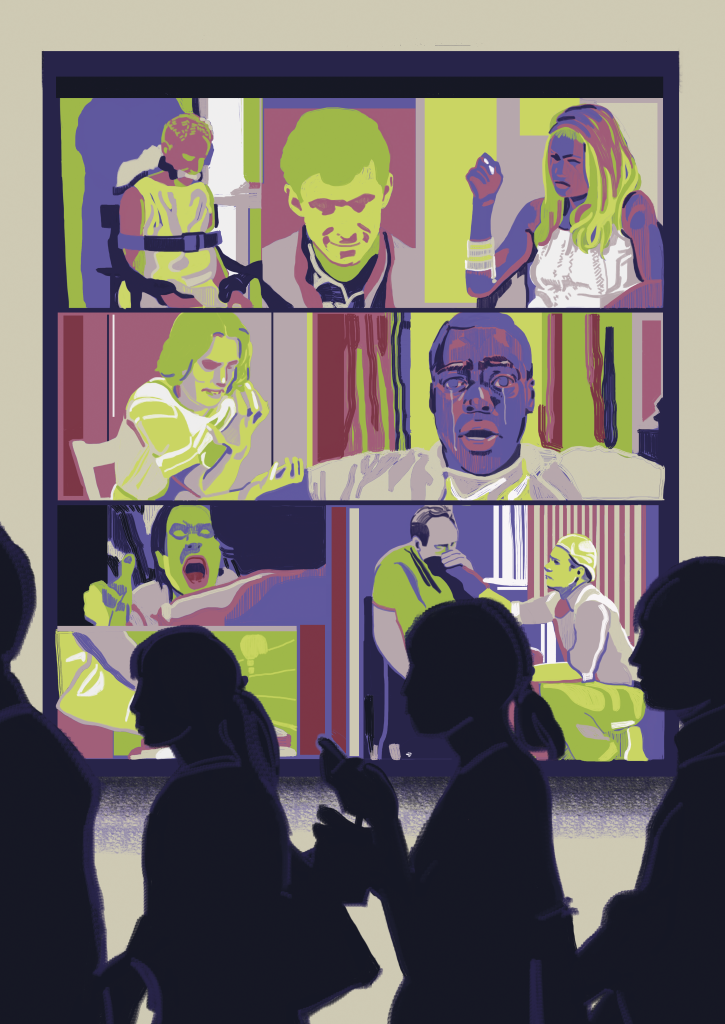Petteri Pietikäinen, who has researched the history of madness for over 20 years, has always been interested in the fate of utopists, anarchists and other outcasts. How has our attitude towards madness changed over time?
“[…] And so the unfortunate sufferer is shackled to a corner or kept in the dark, being fed from a small hole in the wall. There they shall live in their loneliness day and night, in the most miserable condition, hungry and thirsty, sweating in hot weather and then shivering with cold, in the dirt, among parasites. They shall listen to insults and face contempt.”
“Treating the insane” (fin. Mielenvikaisen hoidosta), Savo newspaper, 7/1889
This was the fate of some mentally ill patients back when institutional care was not yet common in Finland. Usually the mentally ill were sold as paupers or they were moved from home to home as lepers – worst case scenario, the mentally infirm were isolated and cuffed.
The excerpt is from Professor of History of Sciences and Ideas at the University of Oulu, Petteri Pietikäinen’s work titled Kipeät sielut: hulluuden historia Suomessa (trans. “Unwell souls: history of madness in Finland”). “Unwell souls” sheds light on the history of mental health in Finland from the 1850s to the 1960s. The work is a sequel to Pietikäinen’s earlier book Hulluuden historia (trans. History of madness), published in 2013.
The semantic shift of hullu: who does it apply to?
In the 1800s, hullu (trans. mad) was still a general term for the mentally ill.
However, the word hullu has always carried other meanings in the Finnish language. According to Pietikäinen, for example, Juhani Aho’s work contains several mentions of the word in both adjective and noun form (i. e. hullu and hulluus). However, Aho refers to the foolishness and unpredictability of people’s actions, not to mentally ill individuals, for example in the statement “Mad is he, who splurges his money on girls” (from the short story Kello, Ensimmäiset novellit, 1883).
According to the dictionary of the Institute for Languages of Finland, another definition of hullu is “wickedly awesome, funny” in contemporary Finnish. This is the definition that, for example, the title Hullut päivät (trans. “crazy days”) carries, referring to the prices of Stockmann’s 5-day long sale.
As modern psychiatry developed in Central Europe in the 19th century, the term hullu was replaced with different diagnoses. Ever since antiquity, madness had been divided into three varieties: mania, melancholy, and frenzy. As the definition transformed into a medical mental illness during the century, the amount of diagnoses multiplied and new illnesses, such as neurosyphilis, schizophrenia, and bipolar disorder were identified. Nowadays, the terms mental health patient and mentally ill are used (The Finnish Blue Ribbon).
So, should the word crazy then be used when talking about the mentally ill? Pietikäinen emphasises that it is not appropriate, unless the mental health patient decides to call themselves crazy, as for example, author and theatre director Juha Hurme has done.
“Juha Hurme is civilised for knowing the original definition of the term hullu”
From closed psychiatric hospitals to outpatient care with the aid of psychopharmaceutical drugs
As the focal point of psychiatry shifted from Europe to the United States in the 20th century, psychopharmaceutical drugs to treat mental disorders were developed. Especially the introduction of chlorpromazine in the United States in 1955 caused a significant turn in psychiatry.
Before the invention of psychopharmaceutical drugs in the 1950s, symptoms of mental health disorders, such as suffering from hallucinations and delirium, would be visible in patients as such. Patients could only be offered, for example, sleep-inducing drugs and narcotics such as chloral hydrate (sometimes referred to as knockout drops) and derivatives of opium, which were not very effective. Nowadays the mentally ill receive medication early on in their sickness, thus relieving their symptoms.
Researchers have estimated the introduction of psychopharmaceutical drugs to have led to the reduction of psychiatric beds. For example in the United States, the number of psychiatric beds has decreased to a tenth in 50 years. Whereas in the 19th century psychiatric institutions were often the final station for the mentally ill, few spend their whole lives in psychiatric hospitals in the 21st century.
According to Pietikäinen, the prescription of strong medication is justified because it enables shorter treatment periods as opposed to longer treatment, which is more costly to society. However, medications do not cure mental illnesses, and they should only be used short-term alongside therapy and social support.
“Of course psychopharmaceutical drugs help, and it is good that we have them, but the systems should not be built to rely on them”, Pietikäinen states.
It’s a social engineering skill: from crazy people to proper citizens
The definition of madness studied by Pietikäinen shall not be limited to people who have got a contemporary psychiatric diagnosis, but shall include all those deviants that society has shut out at some point.

Pietikäinen calls this (mis)treatment of individuals who deviate from the norm social engineering. The concept refers to socio-political planning, which aims to change the behaviour of a certain group of people in a desired way. The focal point of it has gradually shifted from prison management to child protective services, education and health care. The concept gained its prominence through philosopher of science Karl Popper’s work titled The Open Society and its Enemies (1945), and it has mostly been employed in Swedish study of history in the 20th century, especially in discussion about social design and in creating “the people’s home” (swe. folkhemmet); a political concept which played a significant role in the Swedish welfare state in the 20th century.
Political adaptation should always be investigated in its context. A hundred years ago, Finnish society designers had very different ideas as to what a proper citizen was like than contemporary social engineers do. The idea of moulding citizens to fit societal needs is still prevalent.
“The expectations of a proper citizen are imposed on students also by pushing you to graduate as soon as possible and enter the working life”, Pietikäinen points out. Utilitarianism is still prevalent: good taxpayers are desired.”.
According to Pietikäinen, the most important difference between former and present times is that instead of using discipline, the mentally ill aim to be helped using rather gentle means, such as social support and therapy.
Discussion nowadays is more accepting, but the severely ill remain invisible
Another clear difference is that mental health issues are nowadays discussed more openly. “If one uses social media at all, they will encounter discussions about mental health.” However, few talk openly about severe mental illnesses, such as schizophrenia. In the media, severe mental health issues are usually only mentioned in contexts of criminal sentences, which further reinforces the stigma.
“It is different to talk about issues that will pass and ease off than to talk about being in some way chained by that illness forever”, Pietikäinen says.
Pietikäinen finds one reason for this to be the fact that people have an easier time understanding minor mental illnesses, such as depression and anxiety. Each one of us has some sort of personal experience of these. It is difficult to treat people with severe mental illnesses naturally, not having any understanding of their disorders.
“I don’t know what it’s like being severely mentally ill, either – it is such a distant concept.”
On the other hand, experiences shared on social media often bring out the heroic and survival stories: people have recovered from depression or some other mental illness and enthuse over how they survived their illnesses, and what it taught them. The idea of the “proper citizen” is visible even behind this narrative. Can only the already-recovered mental health patients fit into modern society?
Improving the connection between the healthy and the ill – could we learn from the past?
Even before the invention of psychopharmaceutical drugs, we aimed to develop alternative treatments for institutional care – some of which could be used as an inspiration even today. A good example would be the family care, invented in a hospital in the village of Nikkilä, Sipoo in the early 20th century, which gained popularity especially in the time between the wars. Nowadays, the term family care refers to children in foster care being placed in a new family.
In family care, a patient would live in a farmhouse near the hospital and participate in the housework. The patient would be a part of the family’s everyday life just like the other family members, but the family would receive a subsidy from the government.
Although family care never became widespread in all of Finland, it has been proven to have had a positive impact on relieving prejudices. According to research, it seems as though people had a more open attitude toward mental health patients in municipalities where family care was practised.
“If family care was, for example, newly adopted somewhere where there had been a mental hospital for, let’s say, 10 years, people in those areas would have more prejudices against the mentally ill and fear them”, Pietikäinen clarifies. “It has been a big help as people have had the chance to see that mentally ill people are not scary or strange.”
The attitude toward mental health issues has changed during different time periods, and the severely mentally ill have by turns been feared, isolated, medicated and listened to. For example in the medieval times, hearing sounds was not necessarily deemed strange, but it was believed that people experiencing auditory hallucinations had a connection to God.
According to Pietikäinen, mental health problems are part of humanity and life – the line between healthy and ill is eventually quite fine. The surprising misfortunes and setbacks of life can lead to depression and anxiety. On the other hand, it has been indicated that in a state of sensory deprivation, a human becomes delirious, anxious, and begins hallucinating in a few hours.
“The mentally ill are, after all, pretty much the same as us so-called normal people. We also have our episodes at times – and there is nothing mysterious about it, nor is there a reason to fear it.”


